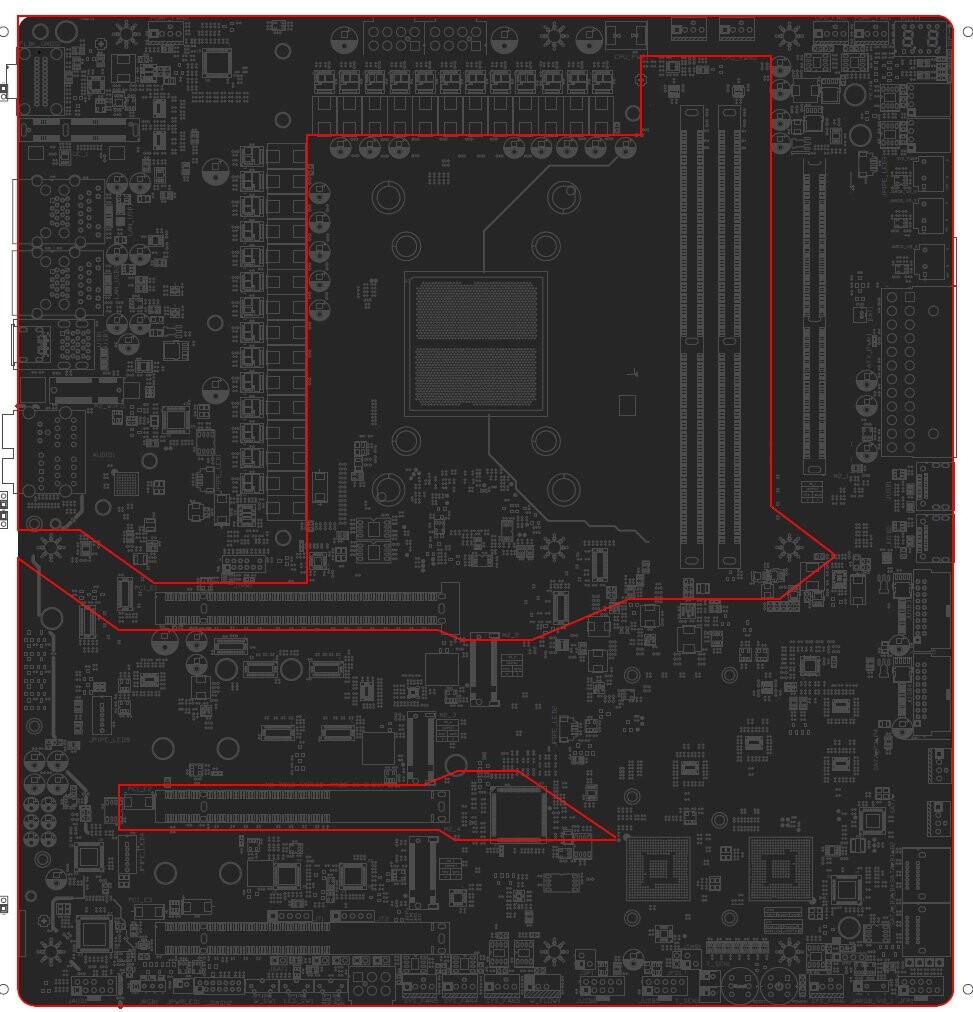X670E Version of Asus Apex Motherboard PCB Diagram Leaked
Leaked board has a whopping 27-phase VRM
A PCB diagram of a high-end AM5 Asus motherboard has been shared online, according to a report by TechPowerUp (originally shared in a Tweet by @harukaze5719, which has since been removed). This motherboard appears to be an AMD version of the high-end overclocking Apex boards, based on its distinctive twin slot memory setup and beefy power delivery system.
If this is indeed an AM5 version of Asus' Apex motherboards, it's the first AMD AM5 board we've seen — the Apex brand has been Intel-only since its inception.
The leaked PCB diagram shows an impressive motherboard setup, the most prominent feature being the power delivery system. The entire VRM set is large, and wraps around nearly half the entire board, with a length nearly as long as the DDR5 memory slots on the left side.
But what's most impressive about this VRM is the number of phases on the board — 27. We can't be sure if Asus is using doublers, but the number is impressive regardless. For some perspective: the Crosshair X570 Extreme has "just" 20 phases, and that board is Asus' flagship AM4 overclocker.
As a result, we can expect this next generation AM5 Apex to pack some serious power under the hood — with enough power delivery to support any type of overvolting and overclocking done on AMD's upcoming Ryzen 7000 series processors.
These chips are expected to be noticeably more power-hungry than their Zen 3 predecessors, with a rumored peak power target of up to 230W and a max TDP of 170W. So the extra phases will probably be required for high-end overclocking.

The defining trait of the PCB design is the dual-slot DDR5 memory configuration on an ultra high-end ATX motherboard — a trait only found on overclocking-exclusive boards. This design choice alone suggests this board is an Apex model, since all Apex boards feature this unique memory design.
Get Tom's Hardware's best news and in-depth reviews, straight to your inbox.
Switching down to dual memory slots can improve the board's memory overclocking capabilities substantially in many cases. Bringing down the slot count from four to two reduces the complexity of the board's traces and shortens them which improves signal integrity.
We don't know how this will impact DDR5 memory performance, but it should enhance this board's overclocking capabilities compared to current DDR5 motherboards on the market. Asus' Z690 Hero peaks at a maximum official supported frequency of 6400MT/s.
We could see this new Apex board featuring support well into the 7000MT/s range, if not 8000MT/s. Prototype DDR5 memory modules have been known to hit well beyond 10,000MT/s in preliminary tests.
Other features worth noting are the triple PCIe x16 slots visible on the motherboard — the top two will probably be Gen 5 models, as AMD's AM5 platform has been confirmed to support the Gen 5 standard. But the secondary slot can clearly be seen as wired to just 8 lanes, due to lane limitations, on the CPU. Finally the third slot can also be seen as a physical x16 slot, but wired for 8 lanes. This slot should be wired into the chipset, and will feature Gen 4 or Gen 3 speeds.
Speaking of the chipset, this board undoubtedly features AMD's higher-end X670 chipset with the dual physical dies present on the PCB layout. AMD's new X670 and X670E chipsets use a "CrossfireX/SLI" setup consisting of two smaller chipsets (instead of one bigger chipset like in previous designs).
But we cannot confirm whether this board will use the mid-range X670 chipset or the flagship X670E chipset. We assume it will use X670E, since this board looks to be a flagship overclocking platform in Asus' lineup.
We don't know for sure if this is going to be an Apex board, but the evidence points towards it being an Apex board for AMD CPUs. Hopefully we'll get more news about this mysterious motherboard as we get closer to the release date of AMD's Ryzen 7000 processors.

Aaron Klotz is a contributing writer for Tom’s Hardware, covering news related to computer hardware such as CPUs, and graphics cards.